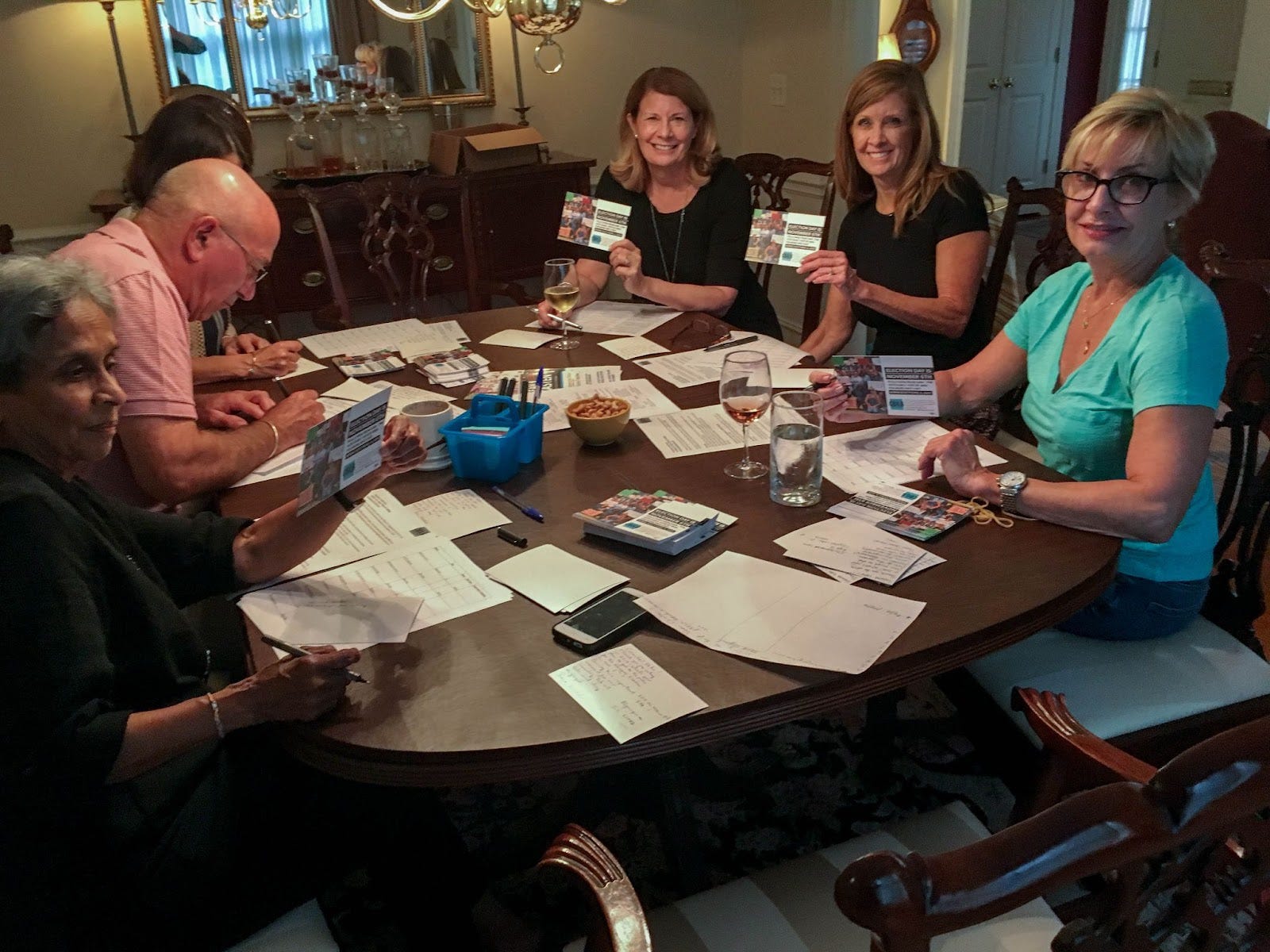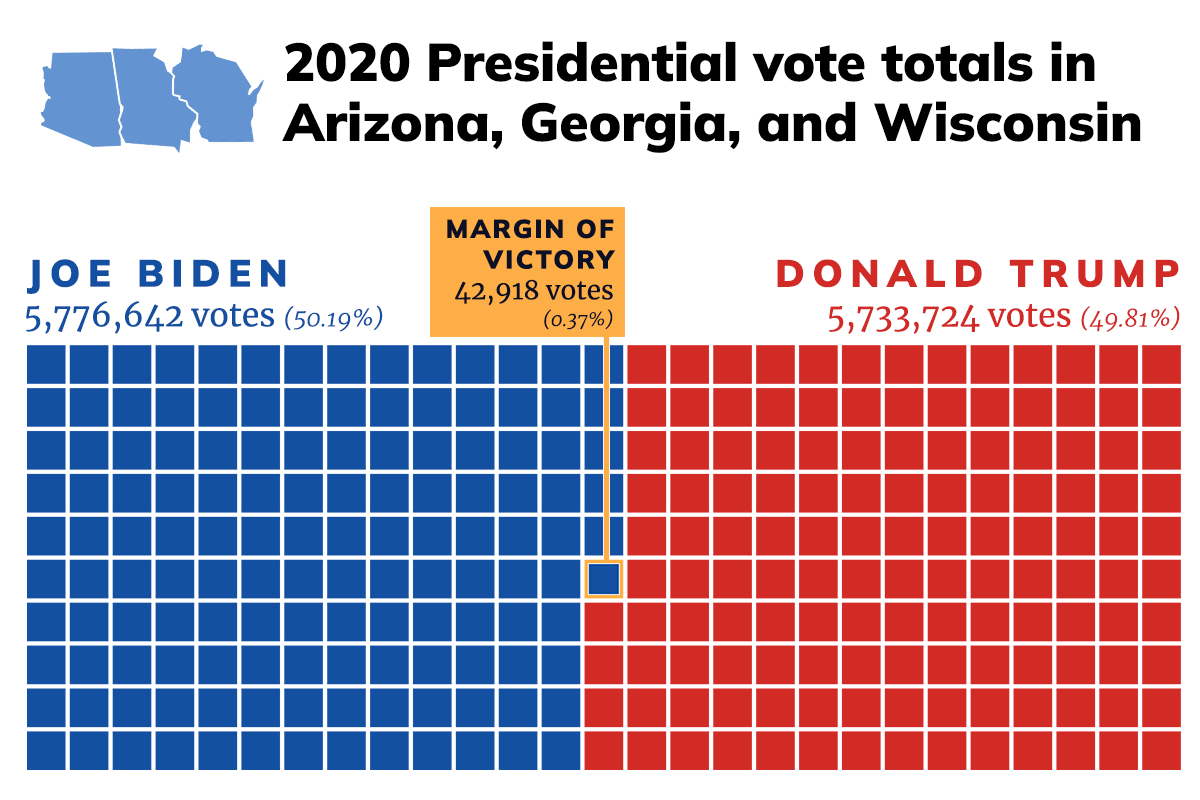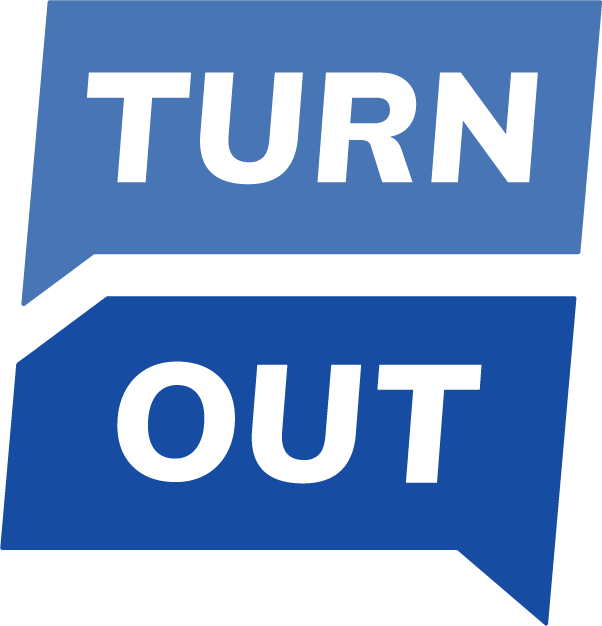About Us: Postcards to Swing States is a Progressive Turnout Project initiative. Our postcard program started in a volunteer’s garage in December 2019. In just two years, our volunteers in all 50 states have sent 29 million handwritten messages to voters, more than any other organization. Progressive Turnout Project is the largest voter contact organization in the country, specifically dedicated to mobilizing the Democratic Party and defending democracy. Our mission: rally Democrats to vote.
How it all started
The 2017 Women’s March and the thousands of grassroots resistance groups that formed in the following days created a huge amount of political power. From the start, many of these groups began to write postcards. If you recall writing postcards or letters to the White House and Mitch McConnell in living rooms and libraries, you’re not alone. Few of us thought those efforts would change the political landscape, but we learned an important lesson: taking action and building community made us feel powerful.
In 2018, a volunteer-led grassroots coalition in Illinois organized dozens of resistance groups and individual volunteers across Chicagoland to write hundreds of thousands of postcards to Democratic voters to help flip a suburban congressional district. Unlike most handwritten postcard efforts gaining steam nationally, the coalition paid to print the postcards and mailed them to volunteers for free. The volunteers wrote a specific message and mailed the cards just prior to the election, when they would be the most effective at increasing turnout.

The organizers worked with data scientists who measured how effective the postcards were and found that those sent ahead of the primary election increased turnout by 1.2% among voters who received the postcards. Just as importantly, the postcard writing served to boost engagement with groups that organized hundreds of volunteers to participate in door-to-door canvassing and phone banking, as well.
As the 2020 elections neared, some of the same volunteers saw an opportunity to replicate the unique postcard program model on a larger scale. They knew postcard writing was a great way to recruit new volunteers into activism. But they also wanted the postcards to have the largest possible impact to increase Democratic turnout in key 2020 swing states.
Launched from a volunteer’s garage in the Chicago suburbs, the program spread entirely by word of mouth, with not a single dollar spent on promotion. Within a year, Postcards to Swing States had over 100,000 volunteers who wrote 21 million postcards to voters in 14 key states in 2020. That’s enough postcards to fill up four semi-trailers. It’s also enough postcards to add thousands of additional Democratic votes in key states.
What follows will answer three important questions:
– How do we know that postcards work?
– What does it mean to be data driven?
– How do postcards complement other volunteer voter engagement?
And finally, we’ll share how handwritten postcards can help us expand the Democratic Senate majority in the 2022 midterms.
How do we know that postcards work?
It’s common to break voter engagement into two categories: turnout and persuasion. Turnout refers to rallying more Democrats to vote, and persuasion refers to convincing more voters to cast ballots for Democrats, rather than Republicans or third-party candidates.
Our recent postcard experiments described below prove that postcards are effective at increasing Democratic turnout.
The most effective way to measure the effectiveness of a voter turnout program is through a randomized controlled experiment. Randomized experiments are the same thing you’ve heard about as a clinic trial for testing prescription drugs and COVID-19 vaccines. You measure the effect of whatever it is you’re doing on a treatment group — in our case, voters who receive postcards — against an almost identical group of people who don’t receive postcards. Then you compare what percentage of the people in the two groups vote. The larger the group sizes and the greater the difference between how many of them voted, the more statistical confidence you have in the impact of your postcards.
Fortunately, there have been hundreds of randomized experiments of voter turnout efforts over the past 25 years, and we’ve learned a lot. Many leading progressive organizations, including Progressive Turnout Project, do randomized experiments and share them either publicly or through membership networks, such as the Analyst Institute.
So what do we know? And what did we learn in 2020?
On average, programs that aim to increase voter turnout are able to get between 0–3% of the people they contact to vote who wouldn’t have otherwise. While these may seem like small impacts, the consequences often mean the difference between winning and losing elections. For example, President Biden won Arizona, Georgia and Wisconsin by a combined 42,918 votes, or 0.37% of the total votes cast in these three pivotal states.

We also know that the impact of our voter turnout efforts are larger in “quieter” elections (such as primaries and special elections) than “noisier” elections (such as presidential elections). This makes sense, because people are more aware of presidential elections and receive far more information than they do for local elections, so each additional ad, canvassing conversation, or postcard has a smaller effect.
Finally, the difference between voter contact modes (canvassing, postcards, etc.) is often smaller and varies a lot based on the design of a particular program, its timing, and how well it’s executed.
Several organizations, including Vote Forward, Sister District, and Postcards to Swing States, have conducted dozens of randomized experiments with handwritten postcards and letters in the past few years. There’s no longer any doubt that these programs increase voter turnout and are often extremely cost effective.
What does it mean to be data driven?
A data-driven approach starts with proven methods to increase turnout, innovates to push the boundaries of our knowledge, and shares both successes and failures with the broader progressive community.
In 2020, we conducted several randomized experiments, and our findings will make our postcards in 2022 even more effective.
In the 2020 Wisconsin primary, we tested four handwritten messages on postcards in a large experiment. Two messages encouraged voters to make a voting plan, and two messages used a framework called social pressure, which we explain below. For each type of message, we tested both a short and a long version.
All four messages we tested increased turnout. Taken together, the postcards increased turnout among the recipients by 0.6%, as well as an additional 0.4% among other members of their households. The short social pressure message was the most effective, increasing turnout by 0.9% versus the control group: “Thank you for being a [previous/first time] voter! Who you vote for is secret, but whether you vote is public information. Vote Tuesday, April 7th!”
Social pressure messages reinforce that voting is a social norm and encourage accountability, often by reminding people that it’s public record who does and doesn’t vote. Social pressure has been extremely well studied and is broadly regarded as the most effective way to increase turnout through direct mail, regardless of age, race or other demographic factors.
There are various forms of social pressure, including gratitude, messages that elicit pride, and those that show a specific voter their past voting history, often called voter report cards.
Some volunteers and voters do find social pressure messages distasteful. It is important to keep in mind that the goal of social pressure messages are to increase turnout, not to make voters happy about receiving a postcard. In fact, numerous studies show that messages that focus on issues, those that are partisan, and those that are motivational tend to increase turnout less than those focused on the voting process. As a reminder, being data-driven means following the evidence — not what we wish would work.

In the November general elections, we conducted three additional large experiments with handwritten postcards, attempting to answer these questions:
- What was the effect of a social pressure message compared to a race-class narrative (RCN) message on turnout?
- What was the effect on turnout of sending voters 1 vs. 2 vs. 3 postcards?
- What was the effect of handwritten postcards with a social pressure message compared to standard printed voter report cards?
Our social pressure message increased turnout by 0.14%, whereas the RCN message had no measurable effect on turnout. While the social pressure effect seems small, the postcards added thousands of votes and were relatively effective in the context of the highest-turnout presidential election in 60 years.
The social pressure message said, “Thank you for being a [previous/first time] voter! Who you vote for is secret, but whether you vote is public information. After the election on Tues, Nov 3, local organizations may follow up with you on your voting record.”
The RCN message said, “We do our best for our families no matter our color, age, or gender. But some politicians divide us so they can block access to affordable healthcare, good schools & clean water. Let’s join together & be voters on Tues, Nov 3!”
Ours was the largest and one of the first experiments to test the effect of a written RCN message on voter turnout. It’s important to note that RCN messages are not just intended to increase voter turnout. They provide a counter to the right-wing narrative and allow Democrats to articulate their values and persuade undecided voters.
We plan to retest a different RCN message in early 2022 in collaboration with Anat Shenker-Osorio, a leading communications strategist and expert on the RCN framework.
In terms of the quantity of postcards, we found that two or three postcards were no more effective at increasing turnout than sending voters a single postcard. This result goes against the findings of most prior studies, which usually show that additional mail pieces are effective with relatively small diminishing returns.
We suspect that spreading the mailing dates out further may have increased the effectiveness, which is a lesson we’ll apply going forward. Due to safety concerns about voting in person due to COVID-19 during the November 2020 election, far more voters opted to vote by mail than ever before. Our mailing dates were separated by only a few days — too late for voters who hadn’t already requested a mail-in ballot to begin that process.
Finally, we found that standard voter report cards increased turnout by 0.42%, as compared to 0.14% for our handwritten social pressure postcards. However, the postcards were nearly three times as cost-effective as the voter report cards, because volunteers provided the postage.
How do postcards complement other volunteer voter engagement?
We’re often asked which method of contacting voters is the most effective. For volunteers, here’s what’s far more important: All voter mobilization tactics are worthwhile. The effect of various means of voter contact are all relatively similar, and it very much depends on the quality of the program, its goals, and what you choose to measure.
Postcards are not better or worse than other tactics. Postcards work to increase Democratic turnout, and we need everything that works in our toolkit in order to win elections and save democracy!
Writing postcards is an especially great option for remote activism. For example, if you live in Portland, Oregon and you want to help make sure Democrats defeat Ron Johnson in Wisconsin and expand the Senate majority, postcards are a great way to help.
Using different methods helps us reach more voters. For example, door-to-door canvassing isn’t always feasible in remote areas, apartment buildings, or retirement communities. Also, many voters don’t answer phone calls from unknown numbers. And young voters are less likely to have an accurate mailing address but more likely to see text messages. When all these methods happen at the same time, we reach more voters. And for those voters we reach in multiple ways, that “layering” is helpful in making them more likely to vote.
Activism isn’t a zero sum. Because our postcard programs start several months prior to an election, groups often focus on writing postcards and then pivot to canvassing and phone banks in the final weeks before the election. Groups all over the country use postcards to recruit new members into activism, and tens of thousands of new activists in 2020 started with postcards, because they’re easy and fit into small blocks of time. For example, many volunteers write postcards in between dinner and helping the kids with homework or while watching Rachel Maddow.
We often hear uplifting stories like this one from a volunteer in Deerfield, IL:
“Initially, when I got the package of postcards, I was overwhelmed and couldn’t believe that I took on another thing that was going to add on to my too long ‘to do’ list that can never seem to get anything taken off of it. However, it honestly has been so calming for me to work on each night. I quietly sit and write out postcards for maybe an hour or so, or I watch TV and write them, or I do them in between helping my kids with their homework, and instead of it being another thing I have to do, it actually makes me less stressed. Writing these postcards makes me feel like I have some small positive thing I am contributing to try to make the world a little bit of a better place. With each postcard, I have a little bit of hope.”

What’s next in 2022 for Postcards to Swing States?
Our midterm postcard programs have been underway since April 2021. We’re sending three waves of postcards to first-time Democratic voters in states with key 2022 Senate races, totaling 4.9 million postcards in all. Tens of thousands of volunteers will mail the third and final round of these postcards to voters in early January 2022.
As we enter this midterm election year, we’ll begin with postcards to increase turnout in the Pennsylvania Senate primary election in May. As we noted above, we’ll test our most effective social pressure message against an RCN message to better understand whether that framework can boost voter turnout. We’ll also measure how many of the additional voters who turn out because of the postcards also end up voting in November. We hope that by rallying more Democrats to vote in the primary, more of them will end up voting in the general election, but only data can answer that question.
Starting in May, we’ll begin writing postcards to Democratic voters in states with key Senate elections, which volunteers will mail in the fall. We’ll send two postcards to the specific voters in our program. The first mailing will be timed to increase vote by mail participation, while the second mailing will focus on Election Day turnout.
We will use social pressure messages in 2022, but we always offer volunteers alternative message options, which are also backed up by data and proven to increase turnout — if not by quite as much. You can always see the messages before signing up.
If you’d like to join us and write postcards, we’ll mail them to you for free — you’re just responsible for the stamps. Sign up at www.turnoutpac.org/postcards.

